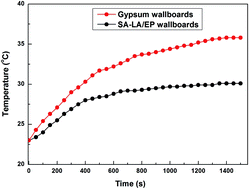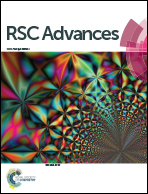Acid-hybridized expanded perlite as a composite phase-change material in wallboards
Abstract
Form-stable composite phase change materials (PCMs) for use in wallboards were prepared by absorbing stearic acid (SA) and lauric acid (LA) eutectic mixtures into the pores of expanded perlite (EP) via vacuum impregnation. The microstructure, thermal properties and the thermal reliability of the composite PCMs were characterized by thermogravimetric and differential scanning calorimetry, X-ray diffraction, Fourier transform infrared spectroscopy, and scanning electron microscopy. The results indicate that the maximum SA–LA absorption of the EP was as high as 65 wt% without any melted SA–LA leakage. The latent heat of the composite PCMs was 119.0 J g−1 at its melting temperature of 31.69 °C and 117.4 J g−1 at its freezing temperature of 30.01 °C. A thermal cycling test showed that the composite PCMs have excellent structural stability and thermal reliability after 100 melt–freeze cycles. A gypsum-based building wallboard containing 6 wt% SA–LA/EP had a low density (0.924 g cm−3), high mechanical strength (2.19 MPa), and remarkable heating preservation performance. These properties indicate that the composite PCMs that we used for wallboards can be considered an efficient heating preservation material for practical applications in building energy conservation.


 Please wait while we load your content...
Please wait while we load your content...